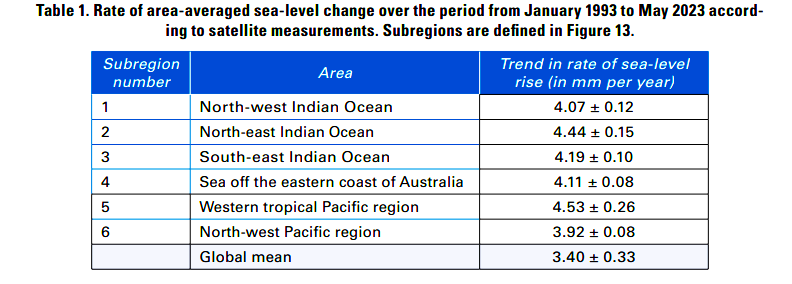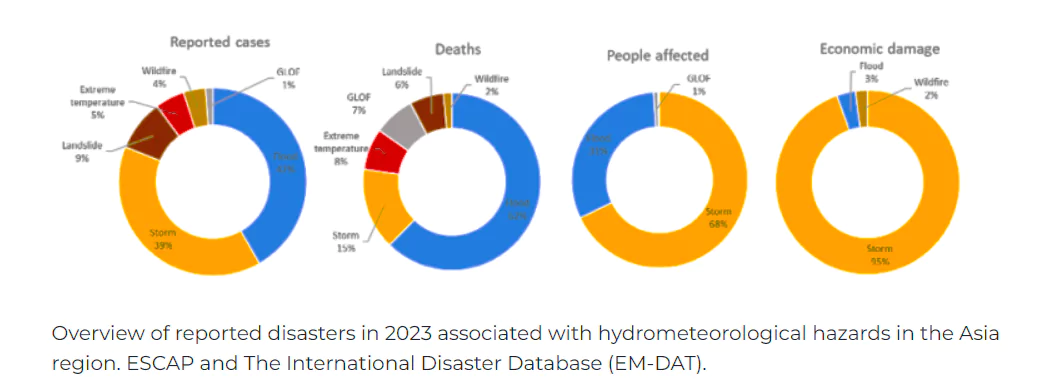Context
Recently, World Meteorological Organization’s (WMO) has published the report “State of the Climate in Asia 2023”.
- Asia is experiencing a warming trend that is almost twice as fast as the global average compared to the period from 1961 to 1990.
About State of the Climate in Asia
- Published by: World Meteorological Organization (WMO).
- Objective: To assess and present the current state of climate conditions and trends across Asia.
- Scope: It covers various aspects such as temperature patterns, precipitation levels, extreme weather events, and their impacts on ecosystems, agriculture, and human populations.
- Data Sources: The report relies on data collected from weather stations, satellite observations, climate models, and scientific research conducted by experts in the field.
Enroll now for UPSC Online Course
Key findings of the WMO Report
Global Climate
- Sea Level: In 2023, the global average sea level continued to rise at a sustained rate (3.43 ± 0.3 mm/year over the period from January 1993 to May 2023).

- Most disaster-hit region: Asia was the region most affected by weather, climate, and water-related disasters in 2023.
- Heat wave intensification: The impact of heat waves in Asia worsened in 2023.
- Dominant disasters: Floods and storms were the most common disasters, leading to the highest number of casualties and economic losses.
- Disaster statistics: 79 hydro-meteorological disasters struck Asia in 2023, with floods and storms making up over 80% of these events.
- These disasters resulted in more than 2,000 deaths and affected over 9 million people.
- Climate change impact: The report highlights that climate change is increasing the frequency and severity of extreme weather events.
- Sea surface temperature rise: In 2023, area average Sea-surface temperatures in the northwest Pacific Ocean reached record highs, with a marine heat wave even affecting the Arctic Ocean.
- The upper layer of the ocean (0 m–700 m) is heating up significantly faster in specific areas like the North-Western Arabian Sea, the Philippine Sea, and the seas east of Japan.
- In these regions, the warming is over three times faster than the global average.
- Precipitation: In 2023, many regions experienced below-average rainfall:
- The Turan Lowland (Turkmenistan, Uzbekistan, Kazakhstan)
- The Hindu Kush (Afghanistan, Pakistan)
- The Himalayas
- Areas around the Ganges and lower course of the Brahmaputra Rivers (India and Bangladesh)
- The Arakan Mountains (Myanmar)
- The lower course of the Mekong River
- Drought in Southwest China: In 2023, southwestern China experienced a drought, with lower-than-usual rainfall throughout the year.
- Temperature anomaly: The annual average near-surface temperature across Asia in 2023 was the second-highest ever recorded.
- It exceeded the 1991-2020 baseline by 0.91 degrees Celsius and the 1961-1990 baseline by 1.87 degrees Celsius.
- Severe Heat Waves:
- Japan’s Record Summer Heat:
- Japan and Kazakhstan both experienced their hottest years ever in 2023.
- The temperatures reached incredibly high levels all over the country.
- China’s High Temperature Events:
- China witnessed 14 extreme heat events during the summer.
- Approximately 70% of the country’s meteorological stations recorded temperatures exceeding 40℃.
- Sixteen stations broke their previous temperature records.

Indian Climate
- Extreme event: In India, floods were the main reason due to which many people died.
- In the North Indian Ocean basin, Extremely Severe Cyclonic Storm Mocha made landfall along the Rakhine Coast in Myanmar.
- It caused widespread destruction.
- Severe Heat Waves: Severe heat waves in April and June caused around 110 reported deaths in India due to heatstroke.
- Widespread Heat in South-East Asia: A big and long-lasting heat wave affected many areas of South-East Asia during April and May.
- It reached from Bangladesh and Eastern India to southern China, with extremely high temperatures.
- During this time, record-breaking heat was recorded.
- Sea- level: In 2023, the sea level rise in the Bay of Bengal was the second-highest in the area, exceeding the global average by 30 percent.
- Precipitation: Rains in the summer-monsoon were below average in India.
Also Read: India’s Heat Action Plans
![]() 24 Apr 2024
24 Apr 2024

